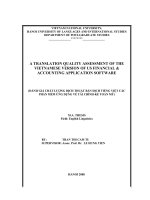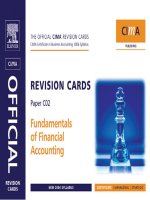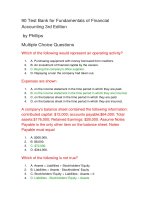Financial accounting fundamentals
Bạn đang xem bản rút gọn của tài liệu. Xem và tải ngay bản đầy đủ của tài liệu tại đây (1.6 MB, 41 trang )
Financial Accounting
Fundamentals
John J. Wild
Third Edition
McGraw-Hill/Irwin
Copyright © 2011 by The McGraw-Hill Companies, Inc. All rights reserved.
Chapter 01
Introducing Financial
Accounting
1-2
Conceptual Chapter Objectives
C1: Explain the purpose and importance of
accounting.
C2: Identify users and uses of accounting.
C3: Explain why ethics are crucial to
accounting.
C4: Explain generally accepted accounting
principles and define and apply
several accounting principles.
C5: Appendix 1B – Identify and describe the
three major activities of organizations.
1-3
Analytical Chapter Objectives
A1: Define and interpret the accounting
equation and each of its components.
A2: Compute and interpret return on assets.
A3: Appendix 1A – Explain the relation
between return and risk.
1-4
Procedural Chapter Objectives
P1: Analyze business transactions using
the accounting equation.
P2: Identify and prepare basic financial
statements and explain how they
interrelate.
1-5
C1
Importance of Accounting
Accounting
Accounting
is a
system that
Identifies
Identifies
Records
Records
Relevant
Relevant
Reliable
Reliable
Comparable
Comparable
information
that is
Communicates
Communicates
about
about an
an
organization’s
organization’s
business
businessactivities.
activities.
1-6
C1
Accounting Activities
Identifying
Business
Activities
Recording
Business
Activities
Communicating
Business
Activities
1-7
Users of Accounting
Information
C2
Internal Users
External Users
•Lenders
•Consumer Groups
•Managers
•Sales Staff
•Shareholders •External Auditors
•Officers
•Budget Officers
•Governments •Customers
•Internal Auditors •Controllers
1-8
C2
Users of Accounting
Information
External Users
Internal Users
Financial accounting provides
external users with financial
statements (shareholders,
lenders, etc.).
Managerial accounting provides
information needs for internal
decision makers (officers,
managers, etc.).
1-9
C2
Opportunities in Accounting
Financial
Financial
•Preparation
•Preparation
•Analysis
•Analysis
•Auditing
•Auditing
•Regulatory
•Regulatory
•Consulting
•Consulting
•Planning
•Planning
•Criminal
•Criminal
investigation
investigation
AccountingAccountingrelated
related
Managerial
Managerial
•General
•Generalaccounting
accounting
•Cost
•Costaccounting
accounting
•Budgeting
•Budgeting
•Internal
•Internalauditing
auditing
•Consulting
•Consulting
•Controller
•Controller
•Treasurer
•Treasurer
•Strategy
•Strategy
•Lenders
•Lenders
•Consultants
•Consultants
•Analysts
•Analysts
•Traders
•Traders
•Directors
•Directors
•Underwriters
•Underwriters
•Planners
•Planners
•Appraisers
•Appraisers
Taxation
Taxation
•Preparation
•Preparation
•Planning
•Planning
•Regulatory
•Regulatory
•Investigations
•Investigations
•Consulting
•Consulting
•Enforcement
•Enforcement
•Legal
•Legalservices
services
•Estate
•Estateplans
plans
•FBI
•FBIinvestigators
investigators
•Market
•Marketresearchers
researchers
•Systems
•Systemsdesigners
designers
•Merger
services
•Merger services
•Business
•Businessvaluation
valuation
•Forensic
•Forensicaccountant
accountant
•Litigation
•Litigationsupport
support
•Entrepreneurs
•Entrepreneurs
1-10
C2
Accounting Jobs by Area
1-11
C3
Ethics—A Key Concept
Ethics
Beliefs that
distinguish
right from
wrong
Accepted
standards of
good and bad
behavior
1-12
C3
Guidelines for Ethical Decisions
Identify
ethical concerns
Analyze
options
Use personal Consider all good
ethics to
and bad
recognize an
consequences.
ethical concern.
Make ethical
decision
Choose best
option after
weighing all
consequences.
1-13
C4
Generally Accepted Accounting
Principles
Financial
Financialaccounting
accounting practice
practiceis
isgoverned
governedby
by
concepts
conceptsand
and rules
rulesknown
knownas
as generally
generallyaccepted
accepted
accounting
accountingprinciples
principles (GAAP).
(GAAP).
Relevant
RelevantInformation
Information
Reliable
Reliable Information
Information
Comparable
Comparable
Information
Information
Affects
Affectsthe
thedecision
decisionof
of
its
itsusers.
users.
Is
Istrusted
trustedby
by
users.
users.
Used
Usedin
incomparisons
comparisons
across
acrossyears
years&&companies.
companies.
1-14
C4
Setting Accounting Principles
In
Inthe
theUnited
UnitedStates,
States,the
theSecurities
Securitiesand
andExchange
Exchange
Commission,
Commission,aagovernment
governmentagency,
agency,has
hasthe
thelegal
legalauthority
authority
to
toestablish
establishreporting
reportingrequirements
requirementsand
andset
setGAAP
GAAPfor
for
companies
companiesthat
thatissue
issuestock
stockto
tothe
thepublic.
public.
The
The Financial
Financial Accounting
Accounting
Standards
Standards Board
Board is
is the
the private
private
group
group that
that sets
sets both
both broad
broad and
and
specific
specific principles.
principles.
The International Accounting Standards Board (IASB) issues international standards that identify preferred accounting practices
in other countries. More than 100 countries now require or permit
companies to prepare financial reports following IFRS standards.
1-15
C4
Principles and Assumptions
of Accounting
Measurement principle (also called
cost principle) means that accounting
information is based on actual cost.
Going-concern assumption means
that accounting information reflects a
presumption the business will
continue operating.
Revenue recognition principle
provides guidance on when a
company must recognize revenue.
Monetary unit assumption means we
can express transactions in money.
Matching principle (expense
recognition) prescribes that a
company must record its expenses
incurred to generate the revenue.
Time period assumption presumes
that the life of a company can be
divided into time periods, such as
months and years.
Full disclosure principle requires a
company to report the details behind
financial statements that would impact
users’ decisions.
Business entity assumption means
that a business is accounted for
separately from its owner or other
business entities.
1-16
C4
Business Entity Forms
Sole
Sole
Proprietorship
Proprietorship
Partnership
Partnership
Corporation
Corporation
1-17
C4
Sarbanes-Oxley Act
In response to a number of publicized
accounting scandals (Enron, WorldCom, Tyco,
ImClone), Congress passed the Sarbanes-Oxley
Act (also called SOX) in 2002 to help curb
financial abuses at companies that issue their
stock to the public. The act requires that public
companies apply both accounting oversight and
stringent internal controls. The desired results
include more transparency, accountability, and
truthfulness in reporting transactions.
1-18
A1
Accounting Equation
Assets
Assets
=
Liabilities
Liabilities
Assets
+
Equity
Equity
Liabilities
+ Equity
1-19
Assets
A1
Cash
Cash
Accounts
Accounts
Receivable
Receivable
Vehicles
Vehicles
Store
Store
Supplies
Supplies
Resources
Resources
owned
owned or
or
controlled
controlled
by
by aa
company
company
Notes
Notes
Receivable
Receivable
Land
Land
Buildings
Buildings
Equipment
Equipment
1-20
A1
Liabilities
Accounts
Accounts
Payable
Payable
Notes
Notes
Payable
Payable
Creditors’
Creditors’
claims
claims on
on
assets
assets
Taxes
Taxes
Payable
Payable
Wages
Wages
Payable
Payable
1-21
A1
Equity
Retained
Retained
Earnings
Earnings
Contributed
Contributed
Capital
Capital
Owner’s
Owner’s
claim
claim on
on
assets
assets
Dividends
Dividends
1-22
A1
Expanded Accounting Equation
Assets
Assets
Assets
Assets
Contributed
Contributed
Capital
Capital
=
=
_
Liabilities
Liabilities
Liabilities
Liabilities
Dividends
Dividends
+
+
+
Revenues
Revenues
Equity
Equity
Equity
Equity
_ Expenses
Expenses
Retained Earnings
1-23
P1
Transaction Analysis
Business activities can be described in terms
of transactions and events. External
transactions are exchanges of value between
two entities, which yield changes in the
accounting equation. Internal transactions are
exchanges within any entity; they can also
affect the accounting equation. Events refer to
happenings that affect an entity’s accounting
equation and can be reliably measured.
Transaction analysis is defined as the process
used to analyze transactions and events.
1-24
P1
Transaction Analysis
J. Scott invests $20,000 cash to start the
business in return for stock.
1-25









